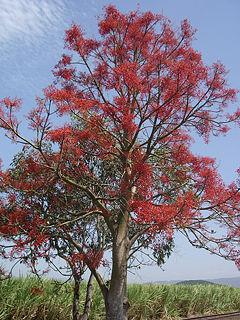- Brachychiton acerifolium
-
Véase también: Delonix regiaBrachychiton

B. acerifoliumClasificación científica Superreino: Eukaryota Reino: Plantae Subreino: Tracheobionta División: Magnoliophyta Clase: Magnoliopsida Subclase: Dilleniidae Orden: Malvales Familia: Malvaceae Subfamilia: Sterculioideae Género: Brachychiton Especie: B. acerifolium Nombre binomial Brachychiton acerifolium
A.Cunn. ex F.Muell. 1857Sinonimia - Sterculia acerifolia A.Cunn. ex G.Don. 1831
- Brachychiton acerifolius A.Cunn. ex F.Muell.
El árbol de fuego illawarra, (Illawarra Flame Tree) Brachychiton acerifolium, es una especie botánica de árbol grande nativo de regiones subtropicales de la costa este de Australia. Es famoso por sus brillantes flores rojas acampanadas, que con frecuencia cubren todo el árbol cuando aún está sin hojas.
Contenido
Nombre común
Junto con otros miembros del género comúnmente se le llama también kurrajong y también se lo ubica como "brachichito".
- Árbol de fuego, árbol de la llama, braquiquito rojo, árbol de las llamas, árbol botella, esterculea.
Descripción
Es tolerante a climas templados, cultivado mundialmente por su belleza; con una altura de 8-15 m, aunque su altura máxima de 40 m solo la alcanza en su hábitat original, cálido. Crece rápidamente, y tiene larga longevidad.
Similarmente como con sus parientes kurrajong, presenta hojas variables, con hasta 7 lóbulos profundos; glabras. Es caducifolio, perdiendo las hojas después de la estación seca. La espectacular floración ocurre a finales de primavera y el nuevo follaje está listo para las lluvias de verano. En áreas donde el invierno no es particularmente seco, este ritmo natural puede llegar a ser algo errático, pudiendo florecer solo parcialmente.
Las flores son campanitas escarlatas con 5 pétalos parcialmente fusionados. Los frutos en forma de vaina (técnicamente conocidos como folículos) son anchos, pardo oscuros, forma de bote y de 1 dm de largo y 1 cm de diámetro. Contiene masas de cerdas que se pegan a la piel. Semillas amarillas, nutritivas y las comen los originarios australianos, después de tostarlas.
Galería
-
Árbol de fuego floreciendo fuera de estación a mediados de abril de 2009, Parque Nacional Real, Australia
Referencias
- Holliday, I. A field guide to Australian trees (3ª edition), Reed New Holland, 2002
- The University of Sydney: Our Indigenous garden
- USDA, ARS, National Genetic Resources Program.
Germplasm Resources Information Network - (GRIN) National Germplasm Resources Laboratory, Beltsville, Maryland. http://www.ars-grin.gov/cgi-bin/npgs/html/taxon.pl?101972 (22 nov. 2007)
- Brako, L. & J. L. Zarucchi 1993. Catalogue of the Flowering Plants and Gymnosperms of Peru. Monogr. Syst. Bot. Missouri Bot. Gard. 45: i–xl, 1–1286.
Enlaces externos
 Wikimedia Commons alberga contenido multimedia sobre Brachychiton acerifolium. Commons
Wikimedia Commons alberga contenido multimedia sobre Brachychiton acerifolium. Commons- http://zipcodezoo.com/Plants/B/Brachychiton_acerifolium.asp
 Wikiespecies tiene un artículo sobre Brachychiton acerifolium. Wikispecies
Wikiespecies tiene un artículo sobre Brachychiton acerifolium. Wikispecies
Wikimedia foundation. 2010.



